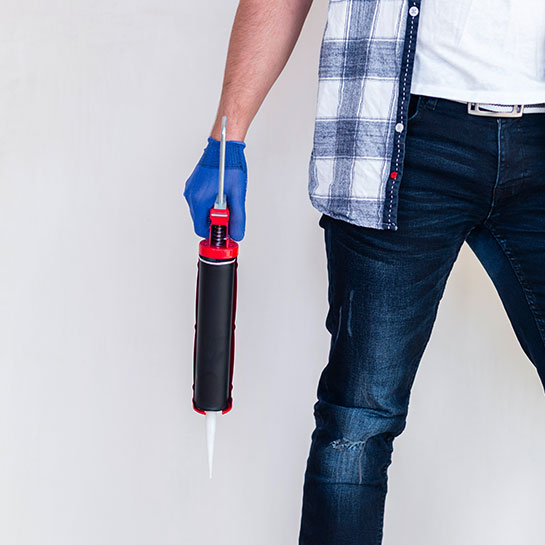There are a multitude of really useful sealing and gluing elements inside the home. In fact, if you look around the bathroom or kitchen, you’ll soon find them. One of the most common is silicone, but how to apply silicone correctly? From ParaTuReforma, we want to explain it to you in this article. As you will see, it is much easier than you think.
Silicone in construction: uses
Silicone is an inorganic polymer that is widely used as a building material. It is derived from polysiloxane and, as its name suggests, the most important element in its formula is silicon, whose atoms alternate with oxygen atoms. It is colorless (although pigments can be added) and odorless.
Now, what is silicone used for in the home? Let’s take a look at the most common cases:
- Inside the bathroom: This material is very useful when sealing the joints of the bathtub, shower tray or screen.
- Inside the kitchen: To seal the sink and countertop.
- In common elements: It is used for filling cracks, sealing window joints and waterproofing.

However, to understand why you can use silicone for these tasks, you must know what its properties are. These are the most relevant ones:
- It is an elastic and flexible material.
- It serves as an electrical insulator.
- It resists moisture, ultraviolet radiation from the sun and extreme temperatures very well. In fact, it maintains its properties between -60 °C and 250 °C.
- It withstands compression deformation very well.
- It is waterproof.
- It is non-toxic and very easy to clean.
Moreover, its application is very simple if you have the necessary tools. Also It also takes very little time to dry.
Types of silicone
Before purchasing and applying silicone in the construction projects you undertake, you must keep in mind that there are several types on the market. In this sense, we must divide them according to two criteria.
According to its composition
First of all, we have to talk about neutral silicone, which is solvent-free and has a high elasticity. As it is completely odorless, it can be used in interior rooms with poor ventilation. It is also very flexible.
Acrylic silicone is recommended for sealing joints in windows, pipes and doors. Why? It is very resistant and you can paint over it once it has dried. Finally, we must refer to acetic silicone, which is the most suitable for exterior sealing jobs.
According to its shape
Liquid silicone is the most common, since it offers great versatility in bonding and sealing different types of materials. Emulsified silicone, on the other hand, because it becomes more solid after the drying process, is more useful for filling cracks.
Similarly, we have to talk about silicones in powder or resin form. However, since they are usually only used in industrial processes, we will be satisfied with just naming them.
How to apply silicone correctly
Now it is time to explain how to apply the silicone. Undoubtedly, a very simple task that will give you perfect results as long as you follow the instructions below:
- Clean the area well: To do this, use water, a microfiber cloth and any specific product for that surface. It is very important that, before applying the silicone, dry everything very well. Any remaining moisture could ruin the work.
- Place the tube or cartridge in the applicator gun: Silicone always comes in a cylindrical tube with a cone-shaped tip. This will allow you to apply it without difficulty through the gun.
- Cut the end of the tube: To do this, you can use a simple knife. Try not to use a serrated knife so that the cut is as regular as possible. You can also use a pair of scissors.
Now you only have to direct the tip of the can towards the place where you want to put the silicone. Then, squeeze the trigger of the gun while you slide it over the entire surface. Do it steadily and without leaving any gaps.
Necessary tools
As mentioned above, the only tool you will need is a silicone gun. This is a tool that you can buy for a small price at any hardware store or even in our catalog. Of course, as we will see in the next section, you will also need a spatula to remove any residues that may have been left.
Cleaning of silicone residues
There is a very simple trick to remove any remaining silicone residue. In fact, it is so practical and effective that even professionals use it. Specifically, it is based on the application of water and soap on the cord. This is how it is done:
- Find a spray bottle and fill it with water: Then add a few drops of dishwashing soap. Do not put too much so as not to generate excess foam, which would prevent you from seeing clearly in the following steps.
- Apply the soap and water to the bead: Be sure to apply the soap and water to the entire silicone bead.
- Remove the residue with a spatula: Gently scrape off the excess silicone. It won’t take long to notice that it doesn’t stick to the tool, which is possible thanks to the soap.
A good tip we can give you to save you this step is to be proactive. But how? Very simple: by placing some masking tape around the line where the silicone bead will go. When you are done, you only have to remove it to remove the excess.
Now you know how to apply silicone correctly in your kitchen, bathroom or any other room in your home. So you just have to enter our online store and buy the cans and tools you need. Of course, if you have any questions, please contact ParaTuReforma. We will be happy to help you solve your problems.

